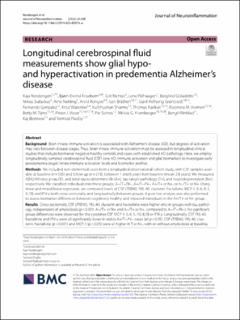| dc.description.abstract | Background
Brain innate immune activation is associated with Alzheimer’s disease (AD), but degrees of activation may vary between disease stages. Thus, brain innate immune activation must be assessed in longitudinal clinical studies that include biomarker negative healthy controls and cases with established AD pathology. Here, we employ longitudinally sampled cerebrospinal fluid (CSF) core AD, immune activation and glial biomarkers to investigate early (predementia stage) innate immune activation levels and biomarker profiles.
Methods
We included non-demented cases from a longitudinal observational cohort study, with CSF samples available at baseline (n = 535) and follow-up (n = 213), between 1 and 6 years from baseline (mean 2.8 years). We measured Aβ42/40 ratio, p-tau181, and total-tau to determine Ab (A+), tau-tangle pathology (T+), and neurodegeneration (N+), respectively. We classified individuals into these groups: A−/T−/N−, A+/T−/N−, A+/T+ or N+, or A−/T+ or N+. Using linear and mixed linear regression, we compared levels of CSF sTREM2, YKL-40, clusterin, fractalkine, MCP-1, IL-6, IL-1, IL-18, and IFN-γ both cross-sectionally and longitudinally between groups. A post hoc analysis was also performed to assess biomarker differences between cognitively healthy and impaired individuals in the A+/T+ or N+ group.
Results
Cross-sectionally, CSF sTREM2, YKL-40, clusterin and fractalkine were higher only in groups with tau pathology, independent of amyloidosis (p < 0.001, A+/T+ or N+ and A−/T+ or N+, compared to A−/T−/N−). No significant group differences were observed for the cytokines CSF MCP-1, IL-6, IL-10, IL18 or IFN-γ. Longitudinally, CSF YKL-40, fractalkine and IFN-γ were all significantly lower in stable A+/T−/N− cases (all p < 0.05). CSF sTREM2, YKL-40, clusterin, fractalkine (p < 0.001) and MCP-1 (p < 0.05) were all higher in T or N+, with or without amyloidosis at baseline, but remained stable over time. High CSF sTREM2 was associated with preserved cognitive function within the A+/T+ or N+ group, relative to the cognitively impaired with the same A/T/N biomarker profile (p < 0.01).
Conclusions
Immune hypoactivation and reduced neuron–microglia communication are observed in isolated amyloidosis while activation and increased fractalkine accompanies tau pathology in predementia AD. Glial hypo- and hyperactivation through the predementia AD continuum suggests altered glial interaction with Ab and tau pathology, and may necessitate differential treatments, depending on the stage and patient-specific activation patterns. | en_US |

